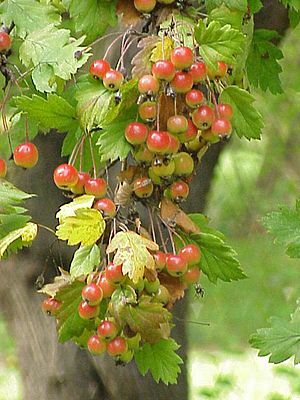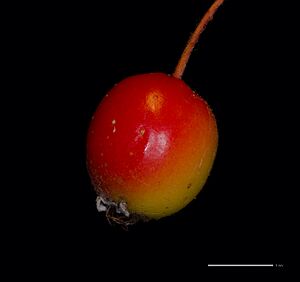Florentine crabapple facts for kids
Malus florentina is a special kind of apple tree often called the Florentine crabapple or hawthorn-leaf crabapple. It naturally grows in places like the Balkan Peninsula and Italy. People also plant it in other parts of the world because it's a beautiful tree to look at.
Quick facts for kids Florentine crabapple |
|
|---|---|
 |
|
| Scientific classification | |
| Synonyms | |
|
Crataegus florentina |
Contents
What's in a Name?
The name florentina comes from the city of Florence, Italy. This city is famous for its amazing Renaissance gardens and a long history of collecting plants. The other common name, 'hawthorn-leaf', describes its unique leaves. They look a lot like the leaves of a hawthorn tree, which is unusual for a crabapple.
About the Florentine Crabapple Tree
This tree loses its leaves in autumn, so it's called deciduous. It grows upright and has a shape like a vase. It can reach up to 8 meters (26 feet) tall and 6 meters (19 feet) wide.
The Florentine crabapple is quite tough! It can handle cold weather down to UK zone 4 and USDA hardiness zone 4–8. This means it's not easily damaged by frost.
Flowers and Fruit
The tree blossoms in June, showing off its pretty flowers. These flowers grow in corymbs, which means they appear in clusters. The seeds inside the fruit ripen later, usually from October to November.
The fruit itself is oval-shaped, about 15 millimeters long and 8 millimeters wide. It ripens in the middle of autumn. Often, the fruit stays on the tree and gets softer, a process called 'bletting'.
Can You Eat the Fruit?
Yes, you can eat the fruit of the Florentine crabapple, either raw or cooked. When the fruit has 'bletted' (become very soft and ripe), it has a soft, slightly sour taste. It can be refreshing in small amounts.
- Important Safety Note:* The seeds of all crabapples contain a small amount of a substance called hydrogen cyanide. While the fruit is safe to eat, it's best not to eat a lot of the seeds, just to be safe.
Growing the Florentine Crabapple
This tree can grow in many different kinds of soil, no matter their pH level. However, it prefers soil that is moist or wet but also drains water well. It loves full sun but can also grow well in a spot that gets some shade.
See also
 In Spanish: Malus florentina para niños
In Spanish: Malus florentina para niños


